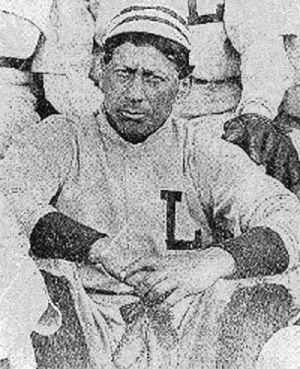Louis Sockalexis facts for kids
Quick facts for kids Louis Sockalexis |
|||
|---|---|---|---|
 |
|||
| Outfielder | |||
| Born: October 24, 1871 Penobscot Indian Island Reservation, Maine, US |
|||
| Died: December 24, 1913 (aged 42) Burlington, Maine, US |
|||
|
|||
| debut | |||
| April 22, 1897, for the Cleveland Spiders | |||
| Last appearance | |||
| May 15, 1899, for the Cleveland Spiders | |||
| MLB statistics | |||
| Batting average | .313 | ||
| Home runs | 3 | ||
| Runs batted in | 55 | ||
| Teams | |||
|
|||
| Career highlights and awards | |||
|
|||
Louis Francis Sockalexis was a famous American baseball player. He was born on October 24, 1871, and passed away on December 24, 1913. People called him the Deerfoot of the Diamond.
Louis Sockalexis was a member of the Penobscot tribe. Many believe he was the first person of Native American heritage to play in Major League Baseball. He played as an outfielder for the Cleveland Spiders team. His professional career lasted for three seasons, from 1897 to 1899.
Contents
Early Life and Talents
Louis Sockalexis was born in 1871. His home was on the Penobscot Indian Island Reservation in Maine. This reservation is near a town called Old Town, Maine. His grandfather was the Chief of the Bear Clan.
Even when he was young, Louis showed amazing athletic skills. People said he could throw a baseball across the Penobscot River. This river separates Indian Island from Old Town. It was also said that he and his father would play catch across the entire Bangor Race Track. This would entertain the crowds watching.
College Baseball Journey
In 1893, Louis played in an amateur baseball league in Maine. He played alongside members of the Holy Cross baseball team. His skills in hitting, running, and fielding really impressed them. One player, Doc Powers, encouraged Louis to join them at College of the Holy Cross.
Louis started college at Holy Cross in 1894. He played baseball, football, and track. During the summers, he continued playing baseball in a league along the Maine coast. He had a very high batting average of .444 at Holy Cross.
In 1897, Louis decided to transfer to the University of Notre Dame. While at Notre Dame, he played both outfield and pitcher. His time there was short, but he continued to show his great talent.
Professional Baseball Career
On March 9, 1897, Louis Sockalexis signed a contract. This was a major league contract with the Cleveland Spiders team. Just over a month later, on April 22, he played his first game in the major leagues.
Challenges and Injuries
Louis faced many challenges during his career. Fans of opposing teams would often shout mean words at him. They would also imitate sounds and dances because of his Penobscot heritage.
On July 4, 1897, Louis hurt his ankle badly. This injury affected how he played. After the injury, his hitting was still good. However, his fielding became difficult. He played in fewer games after that. In his first season, he had a .338 batting average. He also hit three home runs and had 42 RBIs. He also stole 16 stolen bases.
End of Major League Career
Louis played only two more seasons in Major League Baseball. After the 1898 season, the Cleveland Spiders team changed. Many of their best players were moved to another team. Louis was not considered a star player anymore, so he stayed with Cleveland.
In 1899, Louis played only seven games for the Spiders. This team is often called one of the worst in baseball history. After these games, the Spiders released him. This meant his major league career was over.
After the Major Leagues
After leaving the major leagues, Louis played in the minor leagues. He also returned to Indian Island. In 1901, he coached baseball teams for young players. Five of the players he coached later played in the New England League. He played in the minor leagues again in 1902 and 1907 before retiring from baseball.
Later Life and Legacy
In his later years, Louis Sockalexis faced some health problems. He passed away on Christmas Eve in Burlington, Maine, in 1913.
Honoring His Name
Even though his career was short, Louis Sockalexis left a lasting impact. The Cleveland Naps baseball team changed their name to the Indians in 1915. Some people believe this was done to honor Louis Sockalexis. This new name was chosen by sports writers. It was inspired by a nickname given to him when he played for the Cleveland Spiders.
Louis Sockalexis has been honored for his achievements. He was elected into the American Indian Athletic Hall of Fame. A special plaque honoring him stands in Cleveland's Heritage Park. This park is located at Progressive Field, the home stadium of the Cleveland Guardians.
Louis Sockalexis is buried in the Old Town Cemetery in Old Town, Maine.
Who Was First?
There is no official record from Major League Baseball about who was the very first Native American player. For many years, some believed it was a catcher named Jim Toy.
However, recent research has questioned this claim. A writer named Ed Rice looked into Jim Toy's background. He found no proof that Jim Toy was Native American. There were no newspaper reports from his playing days that called him Native. Also, there was no sign that fans or other players thought he was Native. This means that Louis Sockalexis is still widely considered the first Native American to play in Major League Baseball.

